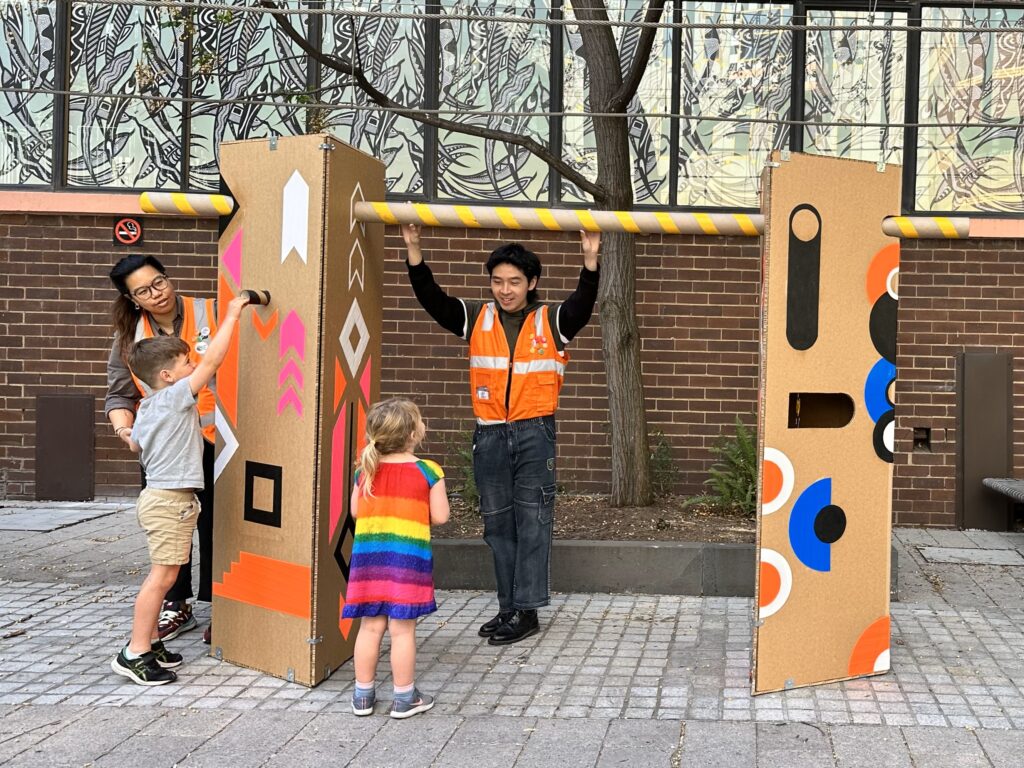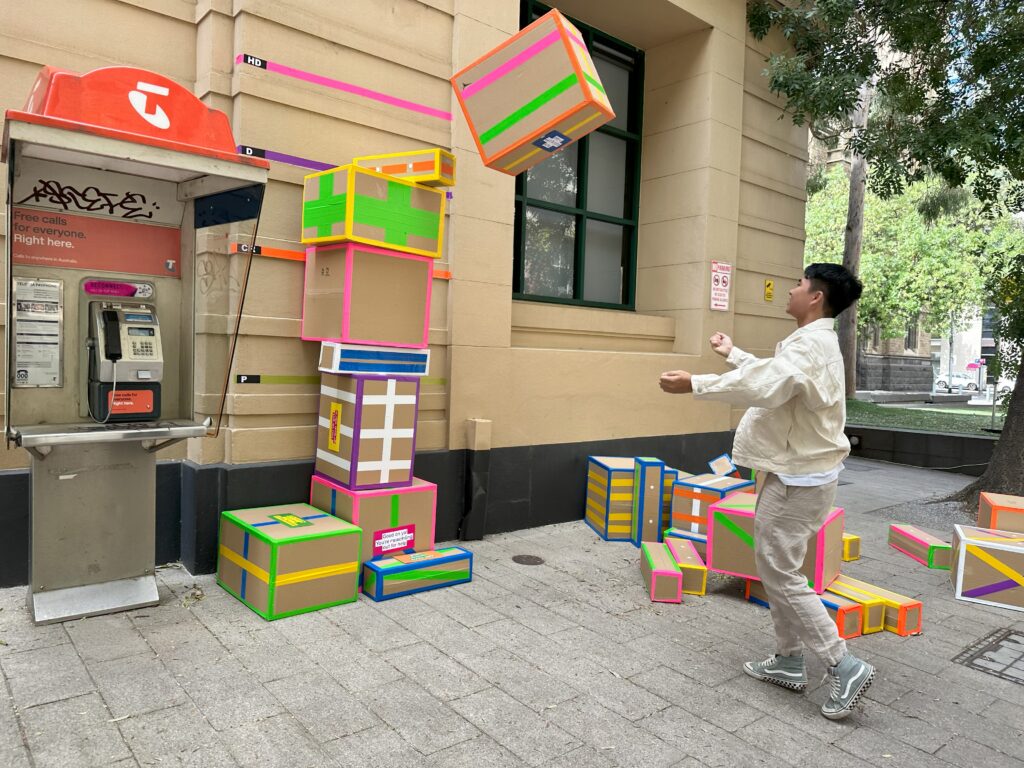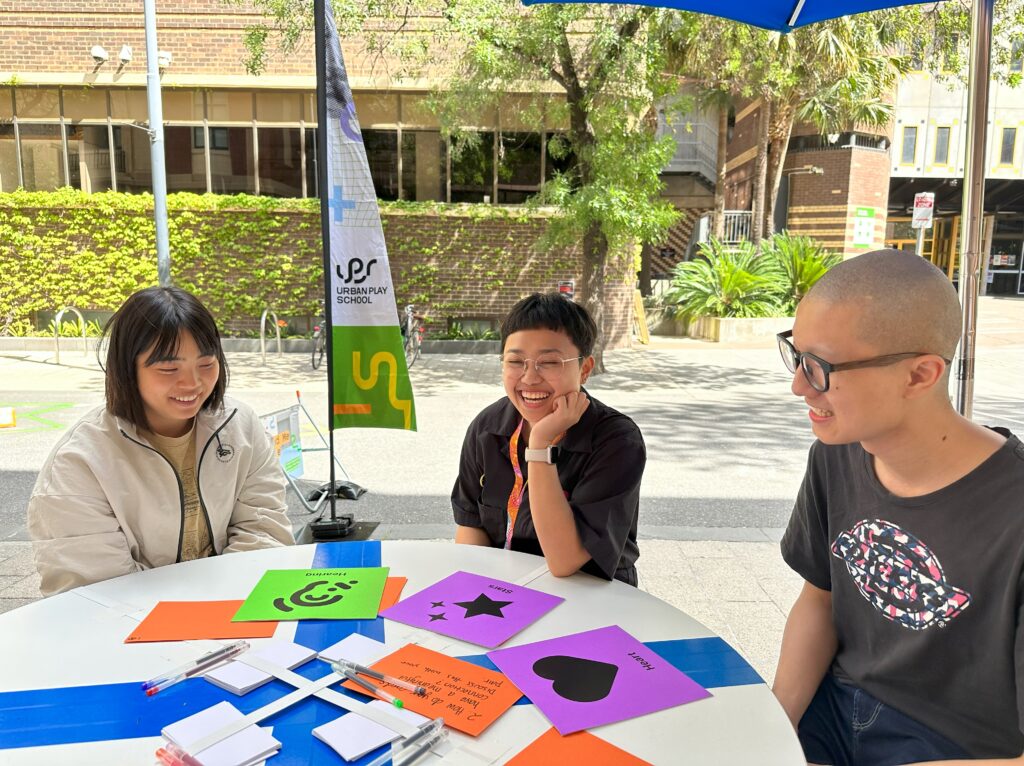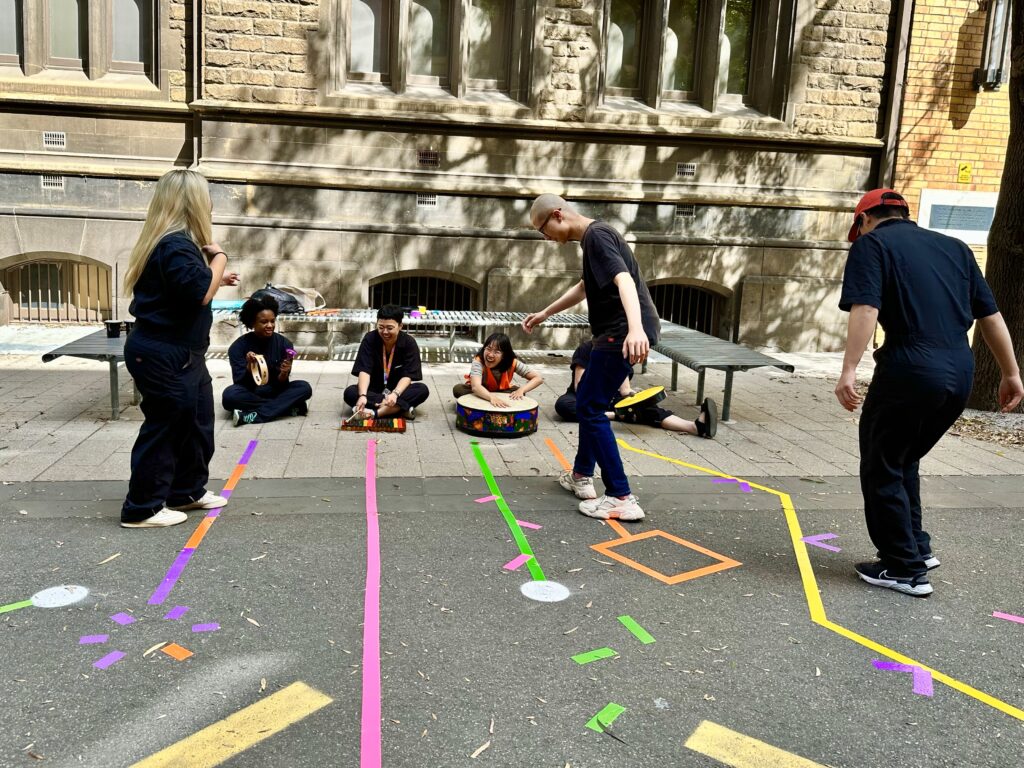During Melbourne International Games Week in October 2023, the Future Play Lab partnered with RMIT Creative and RMIT Culture to create a “playable campus”. Students in the Lab’s “Urban Play School” program designed five different street games or installations that invited passers-by to play with Bowen Street – which runs through the middle of RMIT’s city campus – and with one another in unique and creative ways.
The five games were all made from simple, recyclable material like cardboard and paper tape and used accessible rules or low-tech devices blended with thoughtful game design to transform the street into a playground. They were originally designed for outdoors, but when it rained one day the games were temporarily moved indoors. As the Lab’s director Troy Innocent noted, though, this turned out to be fortuitous since it allowed for “playtesting under different conditions.”
Symphony With

Symphony With by Gin Ling and Nicholas Leong is a playable music sculpture or “sensory toy” evocative of playground equipment. It invites participants to interact with various buttons and tubes on the sculpture to produce different electronic sounds, encouraging collaboration between both friends and strangers to generate a serendipitous symphony in public. It was designed around the concept of music as a “universal language”, using gestures and movement – rather than words – to connect people. Symphony With attracted over 200 participants in total, including about an equal amount indoors and outdoors, and its creators reported many strangers spontenously connecting with each other through the installation.
Stacker

Stacker by Khatim Javed Dar tasks players with stacking colourful cardboard boxes on top of one another against a wall. Players have a set time limit and must act under a series of randomly generated rules, such as using only one’s elbows or head to move the boxes. The game incorporates a scoring feature with markings on the wall that are playfully based on RMIT assessment criteria, with “High Distinction” as the highest score. As a cooperative game, people could work together to stack the boxes, and Dar reported this often happening among strangers, with one person even lifting a complete stranger up so they could stack the final box. At one point, two games ran simultaneously with different groups competing with one another to stack the fastest.
Collectors

Collectors by Lester Dvinagracia Asperga is based on the Filipino street game Patintero. It is a competitive game composed of two teams: defenders, who stand within a demarcated field and must protect stationary tokens; and runners, who try to take the tokens. If a defender touches a runner as they reach for the tokens, that runner is eliminated. The six different tokens each feature an icon representing a different “way of wellbeing”, including “grounded”, “balance”, “active”, connection”, “curiosity”, and “thoughtful”. For Asperga, the fields in the game symbolise the different university semesters during the university experience and the runner has the opportunity to collect these values, either deliberately or unconsciously, through their journey at university. Defenders, meanwhile, must protect those values, and they wear a bib bearing the word, “ikaw” a Tagalog term for “you”, signifying that sometimes what hinders us from attaining these values is ourselves.
Find Me Here

Find Me Here by Elizabeth Amanda is strongly story-driven, based around three stages: “connection”, “reflection” and “gratitude”. It gathers participants into groups and asks them to search their surroundings to locate one of several hidden boxes. In these boxes are various concepts, which participants choose from and assign to another person in the group. Participants are then asked to gather at a table and write down their reflections on a post-it note, which is attached to a “gratitude wall” that documents the “journeys” of each group. Amanda reported many people being drawn to the wall and requesting for it to be kept permanently. The experience was often deeply intimate and tended to work better indoors as post-it-notes were less prone to being blown about by wind.
Yomeci Orchestra

Lastly, Yomeci Orchestra by Uyen Nguyen – based on her previous work with the Future Play Lab as part of the Yomeci Play collective – uses colourful tape markers and musical instruments to create a spontaneous public musical performance. One or more people are tasked with navigating the tape markings by jumping, hopping, stepping or skipping across them, while other participants use various musical instruments to generate an impromptu orchestra based on their movement. Like previous Yomeci iterations, Yomeci Orchestra ingeniously creates the illusion of generative sound through serendipitous collaboration. When the installation moved indoors it attracted fewer people and ended up having to compete with a nearby DJ stationed in front of RMIT’s esports gaming room.
The five installations only ran temporarily over several days during Games Week, but there are plans to make some or all them more permanent features of the RMIT campus. While each of the installations could potentially be developed as “stand-alone” spaces that are left for students and visitors to discover and play with themselves, they also benefit strongly from facilitators – and it is often encounters and conversations with the creators that make them such unique, personal and playful experiences.
Dale Leorke is a postdoctoral research associate at the University of Sydney and a member of the Urban Play Network. All photos supplied by RMIT Creative or the artists.
